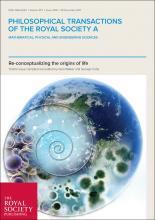
“Therefore, perhaps, life ‘is what it is not, and it is not what it is.’”---Takeuchi, Hogeweg, Kaneko quoting Jean-Paul Sartre
Reunited following their collaborative funding of a $3 million investigation to determine how the religious community would respond to the discovery of life in outer space---NASA Astrobiology Institute (NAI) and John Templeton Foundation, directly and through Templeton-funded entities: Templeton World Charity Foundation and ELSI Origins Network, are principal supporters of a Royal Society year-end publication that seems to want to redefine “life” in order to justify further adventures (space as well as lab).

[Note: Royal Society papers discussed in this article are funded in whole or in part by NAI, Templeton or Templeton-funded entities, unless otherwise indicated.]
Titled: “Re-conceptualizing the origins of life,” theme issue 2109 of Philosophical Transactions of the Royal Society A is really all about re-conceptualizing the living state. Manipulating the definition for what “life” is is the easiest way to ensure that you find “life” where you want to find it in the universe (that would include inside synthetic cell labs).
Curiously, the Royal Society journal cover imitates the Templeton nautilus spiral signature, while inside the articles that are funded by Templeton distance themselves from Templeton views and bear the following disclaimer:
“The opinions expressed in this publication are those of the authors and do not necessarily reflect the views of the John Templeton Foundation.”
But if the views of the authors don’t reflect the views of Templeton, why is a disclaimer necessary? It’s because Templeton is known to support a pairing of science and religion. Plus the Freedom From Religion Foundation filed a Freedom of Information Act request regarding the 2015-2017 collaborative funding of religious scholars by NAI and Templeton.
Marshall, Murray and Cronin in their Royal Society article supported in part by Templeton (how much support is not disclosed) argue:
“A generalized approach that aims to evaluate complex objects as possible biosignatures could be useful to explore the cosmos for new life forms. . . . By remaining too tied to the details of terrestrial biology we risk missing biosignatures presented to us due to our assumptions about what life must be like.”
Lee Cronin further entertains this idea as part of a $860,802 grant from Templeton (2016-2019) to develop what he calls a “Universal Life Detector.” Here’s Cronin’s proposal:
“We will explore this by comparing the complexity of simple molecules to those complex ones found in biology and aiming to establish a threshold to discriminate if the molecule in question could have been generated by a non-biological process, or if it has originated in a living system, either directly as a metabolite, or indirectly by a person (e.g. Earth or Alien chemist), or a living proxy (robot).”

What I’m saying is that by expanding the definition for what life is---beyond biology---as active matter, live systems, whatever—as suggested in the Royal Society origins issue---scientists seem to be embarking on a kind of fantastic voyage, clearly in contrast to what investigators not affiliated with the Royal Society issue have told me in recently published interviews about the days of origins fishing trips being over.
The Royal Society origins issue grew out of a March 2014 white paper on the subject involving Piet Hut at Japan’s Earth-Life Science Institute (ELSI), Nicholas Guttenberg also at ELSI, Norm Packard at ProtoLife et al. Curiously, in a March 2013 book interview, Piet Hut told me he was “new to the origins of life field”:
“I’m actually new to the origins of life field. I’ve been largely involved with physics and other areas of investigation. It was only in December of last year as the Earth-Life Science Institute in Japan started up that I found myself one of the principal investigators, when we decided to delve into the topic of origins of life.”
In the 2014 white paper, Guttenberg---who now also serves as chief data scientist at ARAYA Brain Imaging, Inc. in Japan as well as research associate at ELSI---commented:
“[I]t may be useful to shelve the question of ‘what is life?’ for a while and try to look at the phenomena we associate with emergent structures of this era independent of our biocentricism. Rather than saying ‘what properties are necessary to define life?’, we should ask ‘what broad and qualitatively different properties do we often see in living things that we don’t yet know how to explain?’”
The white paper next led to a Carnegie Institution conference in 2015 chaired by Paul Davies protégé/surrogate Sara Walker, a physicist at Arizona State University. Walker was also co-compiler of the Royal Society year-end theme issue. Through the years Paul Davies, director of ASU’s Beyond Center, has been both a major adviser to Templeton and substantial beneficiary of the foundation’s philanthropy.
The Carnegie conference featured Bob Hazen (Carnegie), Piet Hut (ELSI/IAS), Nigel Goldenfeld (UIUC), Norm Packard (Protolife), Nicholas Guttenberg (ELSI), George Cody (Carnegie), among others.
Further scrutiny of the Royal Society theme issue reveals:
(1) Scientists do not understand what existing life is and so they think that by trying to make life in the lab they may be able to begin to figure it all out. No news here. This is something Jack Szostak said years ago. Walker, Cody and Packard note in their introductory piece (which states Walker, Cody and Packard “received no funding” for the article):
“[I]t is precisely in attempting to understand the transition from non-life to life where we have our best hope of understanding those properties of life that are its most fundamental.”
(2) Walker, Cody and Packard further indicate that scientists think “information may be a key factor” in the origin of life, although investigators don’t understand what “information” is either. I interviewed both Packard, known for chaos theory, and Walker for my book on origin of life. Sara Walker offered this definition for “information” during our 2012 comversation:
“Information can be loosely defined as events that affect and direct the state of a dynamic system. Saying that information is algorithmic really means that specific events are programmed to have specific outcomes in biological systems. So it’s really the processing of the information that’s unique about how biology operates.”
(3) Takeuchi, Hogeweg and Kaneko, in an opinion piece funded by the Japanese government and EU, work around the classic definition for life being linked to Darwinian evolution, noting:
“We can conceptualize the origin of life as the origin of evolution and the evolution of life. Therefore, evolution is at the centre of the origin of life, where the two lines of enquiry must meet.
They conclude by quoting Jean-Paul Sartre: “Therefore, perhaps, life ‘is what it is not, and it is not what it is.’”
(4) Goldenfeld, Biancalani, Jafarpour, in an article funded by NAI on universal biology, recognize a transition to Darwinian evolution following a collective stage---the communal stage is Carl Woese’s 1970s idea--- and they identify these two features common to life: (1) the “canonical genetic code,” and (2) biological homochirality---saying both emerged prior to the Last Universal Common Ancestor state (emphasis added). Goldenfeld et al. look to statistical mechanics to support their argument.
Carl Woese collaborated for many years with Nigel Goldenfeld, who is currently director of the Center for Universal Biology, a NASA Astrobiology Institute at the University of Illinois, Urbana-Champaign.
“Early life was much more collective, much more communal than it is today, particularly the core cellular machinery, such as translational machinery, etc., which was horizontally transferred. We don’t know how that happened. It may well have been that there was massive endosymbiosis, meaning organisms were very porous and could crash into each other and absorb each other on a massive scale and that’s how cellular functions were transmitted. That was an idea Carl proposed in the 1970s in one of his papers [emphasis added].”
[Note: Charles Kurland has said more recently that the concept of endosymbiosis was born in a 1960s pipe dream: “The 60s was a time when many were discovering drugs and the endosymbiosis model is a fitting product of that period. It is a pipe dream.”]
Carl Woese was funded by both NASA and NIH in the 1970s for his work on the Three Domains of Life. In our October 2012 interview, Woese described LUCA this way:
“The universe is a process. Alfred North Whitehead said with biology and other things, we are not dealing with a procession of forms. . . .we are dealing with the form or forms of process. In that distinction lies the essence of what this astrobiology institute here in Illinois is all about. We are really going to study the evolutionary origin of life. Anybody who looks at biology now, with a one percent exception, can feel---anyone with biological intuition can feel---that life is an evolutionary process. As I said, it’s not just a procession of forms.”
Following the death of Carl Woese several years ago, Goldenfeld revealed “Carl had a sub-clinical Asperger’s type of personality, and this meant that he was unable to put himself in the mind of the other person.”
(5) Adam, Zubarev, Aono, Cleaves say our current theories (thermodynamic, chemical, physical and information) are all inadequate to explain life’s origins and they discuss the “new guiding principle” of subsumed complexity:
“Within the framework of a new guiding principle for prebiotic chemistry called subsumed complexity, organic compounds are viewed as by-products of energy transduction phenomena at different scales (subatomic, atomic, molecular and polymeric) that retain energy in the form of bonds that inhibit energy from reaching the ground state. There is evidence for an emergent level of complexity that is overlooked in most conceptualizations of abiogenesis that arises from populations of compounds formed from atomic energy input. We posit that different forms of energy input can exhibit different degrees of dissipation complexity within an identical chemical medium. By extension, the maximum capacity for organic chemical complexification across molecular and macromolecular scales subsumes, rather than emerges from, the underlying complexity of energy transduction processes that drive their production and modification.”
(6) Ikegami, Mototake, Kobori, Oka, Hashimoto in their paper funded by the Japanese government--- “Life as an emergent phenomenon: studies from a large-scale bold simulation and web data”---think a definition of “life” should include the Internet, World Wide Web and social media!
(7) H. James Cleaves (ELSI/IAS) and Markus Meringer (German Aerospace Center) envision “a very different chemical trajectory”:
“First, as it is now clear that the abiotic organic chemical space of the Universe is very large, it must be acknowledged that far less is known about prebiotic chemistry which led to the origin of life than has perhaps been presumed.
Second, as many of the secondary metabolites which make up the grand diversity of biological natural products come from metabolic transformations mediated by evolutionarily derived enzymes, and the chemical space to be explored is so incredibly large, it is likely that there is little overlap of the compounds with abiological samples, and possible that an independent biochemistry might develop along a very different chemical trajectory.”
(8) Mamajanov & Cody consider the possibility “that catalysis may have originally been performed by hyperbranched polymers.”
(9) Kacar, Guy, Smith, Baross look at the deep past by reconstructing sequences of proteins that might have existed in ancestral organisms---palaeophenotype reconstruction. (See also Kurland & Harish on Deep Evolution.)
(10) Santa Fe Institute’s Jessica Flack worked with two Templeton grants for her research on “Coarse-graining.”
(11) Even Bob Hazen’s research was supported by Templeton. Hazen takes a physical science perspective to life’s origins in his Royal Society article, saying, (1) there are a “range of probabilities for many natural events”, and (2) just because you can’t make it happen in the lab doesn’t mean it is not inevitable on an Earth-like planet.
Hazen, in response to Jerry Fodor’s comment to me: “Astrobiology doesn’t exist. What are its laws?” said this in defense of the field in our 2008 book interview:
“Of course astrobiology exists. Any human endeavor “exists” where there’s a group of people, in this case probably 1,000 researchers, who have a common set of goals and aspirations”.
As part of Hazen’s $400,000 grant (2017-2020) from Templeton, he plans to produce 15 seminars and public lectures on origins of life and astrobiology.
Several of the Royal Society articles discuss the importance of computation to the field. Among them: “Origin of life in a digital microcosm”; “An intermediate level of abstraction for computational systems chemistry”; Bulk measurements of messy chemistries are needed for a theory of the origins of life”; and “The thermodynamic efficiency of computations made in cells across the range of life”.
The Royal Society issue is largely about science that Darwin never dabbled in, and may never have even dreamed of, and yet there is an inclination in the issue to cling to the Darwinian cliff. Nonetheless, it is good to know what the scientific establishment are up to and this collection of articles is open access.
The big question is: Are scientists reaching out to inspire and be inspired by the public or publicly engaging to solicit funds for a ramping up of space adventures and for basic research that looks to spin off discoveries commercially?
